You are here
Trustees Warn: Social Security Faces Major Imbalances
Social Security provides retirement and disability benefits to 60 million people — nearly one out of every five Americans. As the population ages and the large baby boom generation enters retirement, more and more people will be collecting benefits, while at the same time fewer workers will be paying taxes to support each beneficiary.
In its annual report, the independent trustees of Social Security warned that, absent reforms, this demographic shift will create major financial challenges for Social Security:
- The combined Social Security trust funds are projected to be fully depleted by 2034. Without legislative action, 89 million beneficiaries could face across-the-board benefits cuts of 21 percent in 2034 — only 19 years from now.
- Specifically, Social Security’s Disability Insurance program will be depleted much sooner — in 2016. Without legislative action, 11 million disabled people and their families could face across-the-board benefit cuts of 19 percent next year.
Social Security is a critical government program for many Americans, and lawmakers should work together to address these imbalances and make the program sustainable for the long term. The good news is that many solutions exist — as the Trustees emphasize in their report: "With informed discussion, creative thinking and timely legislative action, Social Security can continue to protect future generations."
WHAT IS SOCIAL SECURITY?
Social Security is the largest single federal program, and accounts for approximately one quarter of federal spending. Almost every American worker pays a dedicated payroll tax that entitles them (as well as their spouses and survivors) to benefits when they retire or become disabled.
The payroll taxes and other revenues are deposited in two trust funds: the Old Age and Survivors Insurance Fund (OASI) and the Disability Insurance Fund (DI). OASI provides benefits for retired workers and their families; DI provides benefits for disabled workers and their families. Of the 60 million people who currently receive Social Security benefits, approximately 82 percent receive payments through OASI, and the remaining 18 percent receive DI benefits.
How Do Demographic Trends Affect Social Security’s Finances?
The retirement of baby boomers and the aging of the population creates serious financial challenges for Social Security. As baby boomers retire and life expectancy continues to increase, the number of Social Security beneficiaries is projected to climb sharply over the next several decades. By 2034, the total number of beneficiaries is projected to reach 89 million, nearly 50 percent more than the number in 2015. Over the same period, the ratio of workers paying taxes to support each Social Security beneficiary will decline by a third, from 3:1 to 2:1.
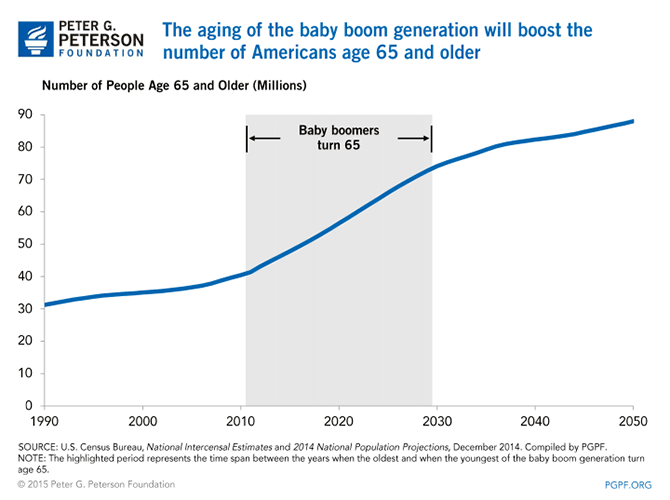
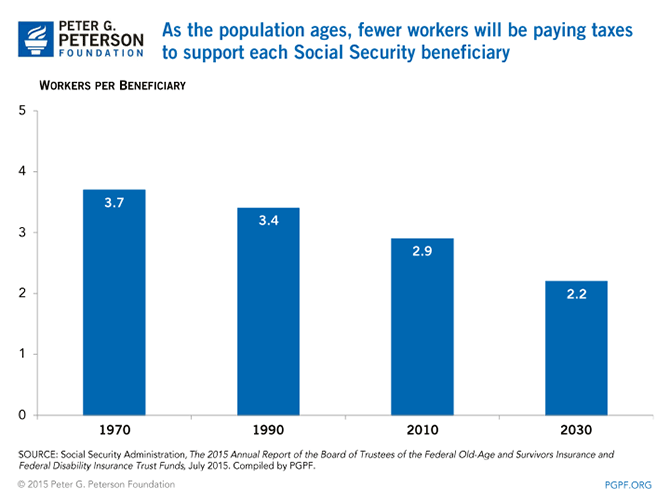
This very predictable, growing mismatch between the number of people paying into Social Security and the number receiving benefits will cause Social Security spending to increase significantly more than revenues will increase. Trustees project that OASDI outlays will grow from 5.0 percent of GDP in 2015 to 6.0 percent by 2034 — a 20 percent increase. By contrast, the system’s revenues will remain relatively constant, increasing only slightly from 4.5 percent of GDP in 2015 to 4.8 percent of GDP in 2034. These budgetary imbalances will translate into growing annual cash deficits in the program’s trust fund.
The Social Security Trust Funds
The Social Security trust funds conduct the financial operations of the OASDI programs — income from taxes and interest are credited to the funds, and disbursements for benefits and administration are deducted from the funds. The Social Security Administration (SSA) has the legal authority to spend any accumulated balances in the trust funds, plus any incoming revenues, on benefits. However, once a trust fund balance reaches zero, spending on benefits cannot exceed incoming revenues.
Between 1984 and 2009, the program ran significant cash surpluses. These surpluses were primarily the result of policy changes enacted in the 1980s that slowly raised the retirement age and increased payroll taxes. These cash surpluses allowed Social Security to accumulate substantial trust fund balances during the 1990s and early 2000s.
It is important to understand, however, that the actual cash surpluses generated by Social Security have already been used. The funds were not actually set aside in any way — instead, they were used to pay for other government operations. This effectively reduced the level of overall deficits and debt that the government took on. For accounting purposes, the Social Security surpluses have been recorded as balances in the Social Security trust funds, which are also recorded as dollar-for-dollar liabilities of the Treasury. Therefore, the net effect of the Social Security trust funds is zero for the government as a whole. And from a cash financing perspective, the Treasury is forced to borrow new funds from the public for every dollar that Social Security runs in cash deficits. As a result, the trust funds have no real effect on government’s overall finances.
In 2010, Social Security began running cash deficits (excluding interest)1. In 2015, Social Security’s cash deficit is projected to be approximately $84 billion. Between now and 2034, the annual cash deficits will add up to $2.8 trillion dollars. During this period, the trust fund balances will be reduced, and the Treasury will be forced to borrow funds from the public. By 2034, the trust fund will be fully depleted.
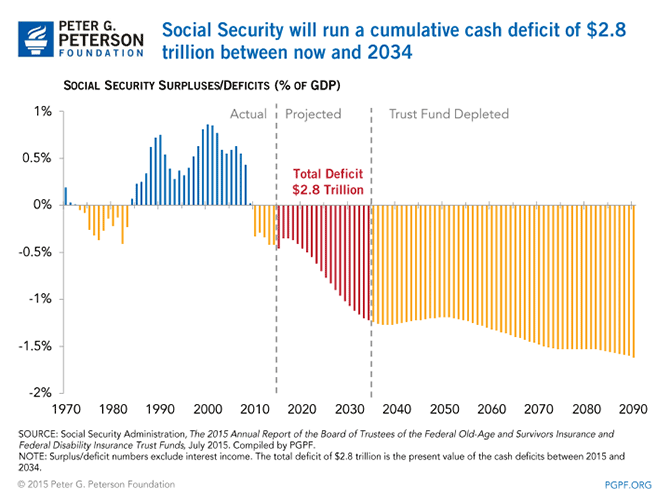
The trustees project that the combined OASDI trust fund balances will be fully depleted in 2034, and Social Security will no longer be able to pay full benefits. At that point, 89 million beneficiaries could face a 21 percent cut in benefits: for a retiree with average pre-retirement earnings, that amount is approximately $5,325 in today’s dollars.2
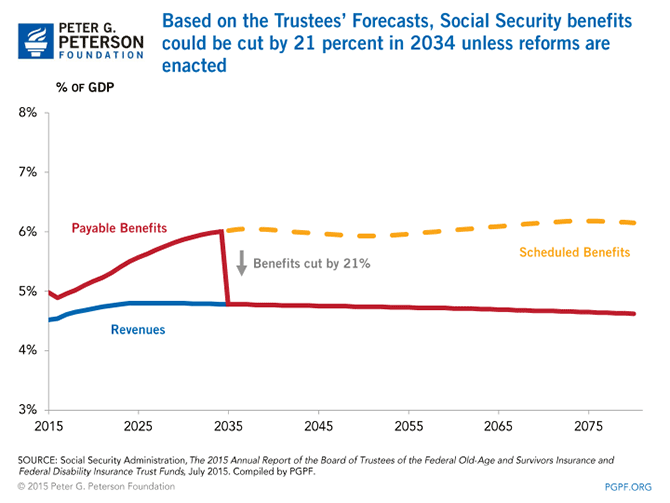
A disruption in benefits of this magnitude would impose huge burdens on low-income seniors because Social Security is a major source of their income. Social Security provides more than 80 percent of the income of seniors in the bottom 40 percent of the income distribution (those with $22,000 or less in total income).
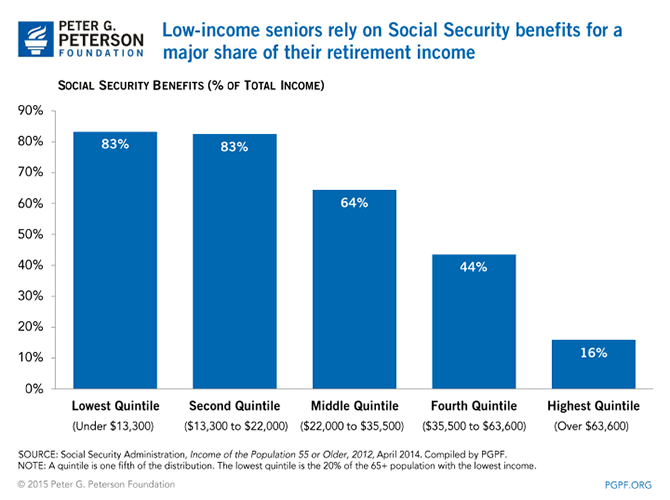
The outlook for the Disability Insurance (DI) Trust Fund is even more dire. The DI Trust Fund has been running deficits since 2009 and its balances will be depleted next year. At that point, the DI trust fund will not be able to pay full benefits on a timely basis — benefits for 11 million disabled Americans and their families could be cut by 19 percent, reducing the annual benefit for a recipient by approximately $2,545, on average.3 Based on this situation, the Trustees urge that "legislative action is needed as soon as possible to address the disability insurance program’s financial imbalance."
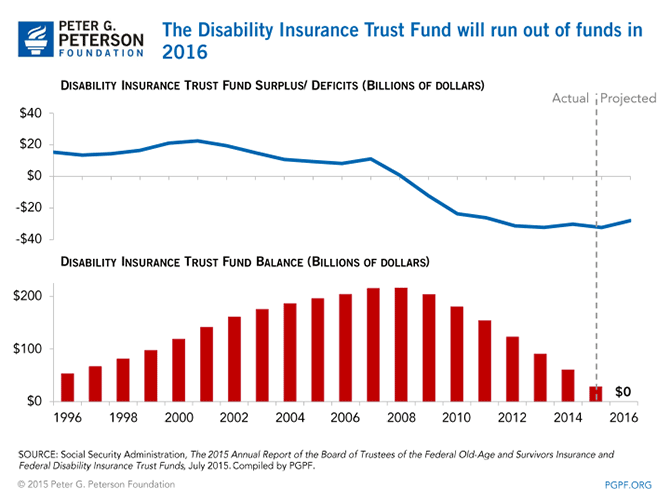
Solutions
The good news is that many policy solutions are available to improve the financial outlook of Social Security. In 2010, the Congressional Budget Office published a report containing thirty options for improving the long-term stability of the program. Examples of reforms include: reducing annual cost of living adjustments, increasing payroll taxes, reducing initial benefits, and raising the retirement age.
Importantly, if policymakers act sooner rather than later, they will have more and better options, which can be gradually implemented to reduce the impact on current and future beneficiaries. Conversely, every year of delay and inaction limits options and makes reform more difficult, which will require larger benefit cuts, higher taxes, or both.
For their basic financial planning, the American people need to know well in advance what benefits they will receive in retirement. If benefit levels are to be cut, people should be given ample warning so they have time to adjust their saving and retirement plans. If taxes are to be raised, people also need to incorporate those changes into their planning.
The math is simple and the consequences of inaction are clear. Policymakers should work together to stabilize and strengthen this important program for generations to come.
1Social Security also receives interest income from its Treasury securities, but this income is offset by an interest cost to the Treasury, making the flows net to zero from the perspective of the overall federal budget. (Back to citation)
2A retiree with average pre-retirement earnings is someone whose earnings, over the course of their career, is equal to average to 100% of the national average wage index. If Social Security were fully financed, it would provide these retirees with $25,357 in inflation-adjusted benefits in 2034. With a 21% cut in benefits, annual benefits would be reduced by $5,325 to about $20,032. (Back to citation)
3Total disability benefit payments for 2016 are projected to be $148.6 billion, distributed to 11.1 million beneficiaries. On average, disability beneficiaries are projected to receive $13,410 in annual benefits in 2016. A 19% cut would reduce these average annual benefits by $2,550. (Back to citation)
